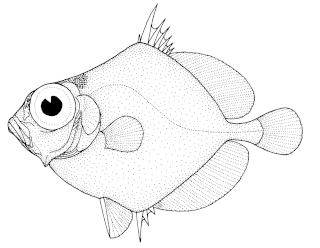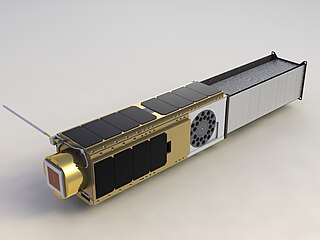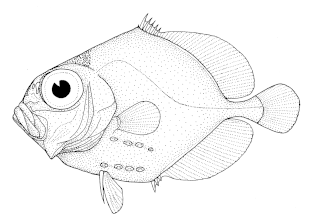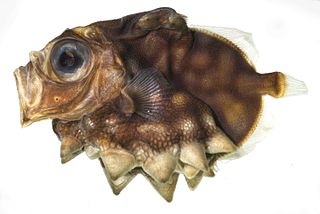| Neocyttus | |
|---|---|
 | |
| False Boarfish (N. helgae) | |
| Scientific classification | |
| Kingdom: | Animalia |
| Phylum: | Chordata |
| Class: | Actinopterygii |
| Order: | Zeiformes |
| Family: | Oreosomatidae |
| Subfamily: | Oreosomatinae |
| Genus: | Neocyttus Gilchrist, 1906 |
| Neocyttus | |
|---|---|
 | |
| False Boarfish (N. helgae) | |
| Scientific classification | |
| Kingdom: | Animalia |
| Phylum: | Chordata |
| Class: | Actinopterygii |
| Order: | Zeiformes |
| Family: | Oreosomatidae |
| Subfamily: | Oreosomatinae |
| Genus: | Neocyttus Gilchrist, 1906 |
There are currently four recognized species in this genus: [1]

Oreo is an American sandwich cookie consisting of two wafers or biscuits with a sweet crème filling. Introduced on March 6, 1912, Oreo is the best-selling cookie brand in the United States. As of 2018, the version sold in the U.S. is made by the Nabisco division of Mondelez International.

The common name dory is shared by members of several different families of large-eyed, silvery, deep-bodied, laterally compressed, and roughly discoid marine fish. As well as resembling each other, dories are also similar in habit: most are deep-sea and demersal. Additionally, many species support commercial fisheries and are considered excellent food fish. Most dory families belong to the order Zeiformes, suborder Zeioidei:

Oreocereus is a genus of cacti, known only from high altitudes of the Andes. Its name means "mountain cereus", formed from the Greek prefix oreo- and the New Latin cereus, meaning wax or torch.

The oreos are a family, the Oreosomatidae, of marine fish. Most species are found in the Southern Hemisphere, inhabiting continental slopes down to about 1,000 m (3,300 ft) deep. Most of then are 43 cm at most, with the largest species reaching a length of 60 cm. Though they are small, they often have incredibly elongated lifespans, probable result of living in the deep sea with the Warty oreo being able to live up to 210 years, which puts it at one of the longest living vertebrates on Earth. They borrow their name from the Greek oreos (mountain) and somas (backs) for the shape of their backs. They are very flattened vertically-laterally, with 5 to 8 rays in their dorsal fin, and 2 to 4 in the anal fin, and only 1 spine in the pelvic fins. The upper part of the mouth is protractile, allowing them to snatch up little fishes, copepods, amphypods, shrimp, krill, and small cephalopods, their main diet.

The smooth oreo or smooth dory,, is an oreo, the only species in the genus Pseudocyttus. It is found in all southern oceans at depths of between 400 and 1,500 metres. Its length is up to 60 centimetres (24 in).

The spiky oreo is an oreo of the genus Neocyttus, found in all southern oceans at depths of between 200 and 1,300 m. Its length is up to 40 cm.

Hydrox is the brand name for a cream-filled chocolate sandwich cookie manufactured by Leaf Brands. It debuted in the United States in 1908, and was manufactured by Sunshine Biscuits for over 90 years. Hydrox was largely discontinued in 1999 three years after Sunshine was acquired by Keebler, which was later acquired by Kellogg's. In September 2015, the product was re-introduced by Leaf Brands.

Adeleorina is a suborder of parasites in the phylum Apicomplexa.

The Haemosporida are an order of intraerythrocytic parasitic alveolates.

The O/OREOS is an automated CubeSat nanosatellite laboratory approximately the size of a loaf of bread that contains two separate astrobiology experiments on board. Developed by the Small Spacecraft Division at NASA Ames Research Center, the spacecraft was successfully launched as a secondary payload on STP-S26 led by the Space Test Program of the United States Air Force on a Minotaur IV rocket from Kodiak Island, Alaska on November 19, 2010.

Turris is a genus of sea snails, marine gastropod mollusks in the family Turridae, the turrids.
Aggregata is a genus of parasitic alveolates belonging to the phylum Apicomplexa.

Allocyttus is a genus of oreos.

Oreosoma atlanticum, also known as the ox-eyed oreo, is a species of oreo found in oceanic deep waters at depths of from 220 to 1,550 m. This species grows to a length of 21 cm (8.3 in) TL. This species is the only known member of its genus. Although adults are more similar in shape to other oreos, the juveniles have a weird plating/armor in their skin, which is spiked and probably makes them harder to eat for any hostile creature. Adults lack that plating, and, as other oreos, they have a protractile mouth and very large eyes, with small scales.
Merogregarina is a genus of parasitic alveolate in the phylum Apicomplexa. Species in this genus infect marine invertebrates.
The Metarbelidae are a family of the Cossoidea also called the carpenter or goat moths, and is sometimes treated as a subfamily, Metarbelinae of the Cossidae. No synapomorphies are shared with the Cossidae based on adult morphology. The family Metarbelidae was first described by Embrik Strand in 1909.

A deep-fried Oreo is a dessert or snack consisting of an Oreo which is dipped in batter and deep-fried. It can be served with different toppings or simply with no toppings. Deep-fried Oreos are generally made using the Oreo cookies by the Nabisco division of Mondelēz International, but also can be made of other chocolate sandwich cookies.

Android Oreo is the eighth major release and the 15th version of the Android mobile operating system. It was first released as an alpha quality developer preview in March 2017 and released to the public on August 21, 2017.
Oreoleptidae is a family of flies. The family was established in 2005 on the basis of the type species Oreoleptis torrenticola placed in the monotypic genus Oreoleptis. The only known species was collected from the Rocky Mountains where the larvae grow in torrential streams. Larvae have also been found in groundwater wells. The larvae are similar to those of Athericidae and Tabanidae but with long crocheted false-legs (prolegs) arising from abdominal segments 2-7. The larvae have hollow mandibular hooks.
Oreo is a genus of Australian araneomorph spiders in the family Gallieniellidae, and was first described by Norman I. Platnick in 2002. The name derives from the Oreo cookie. The type species has a black and white abdomen, although such coloration is common among gallieniellids.